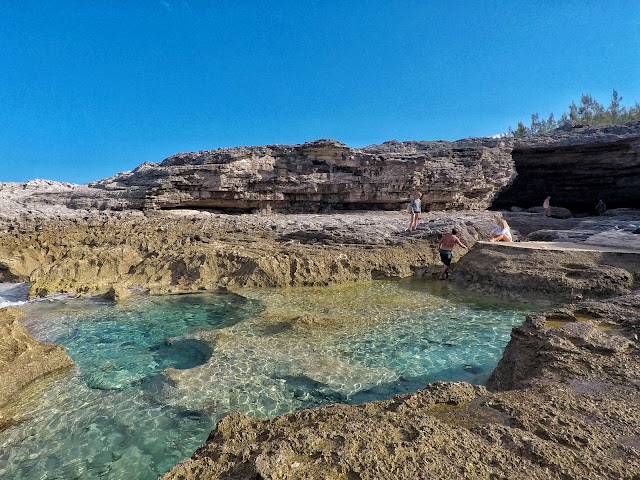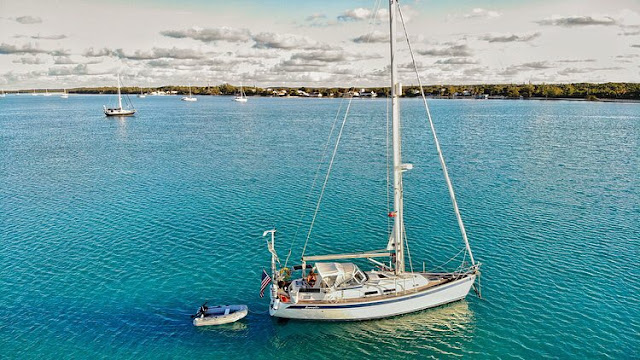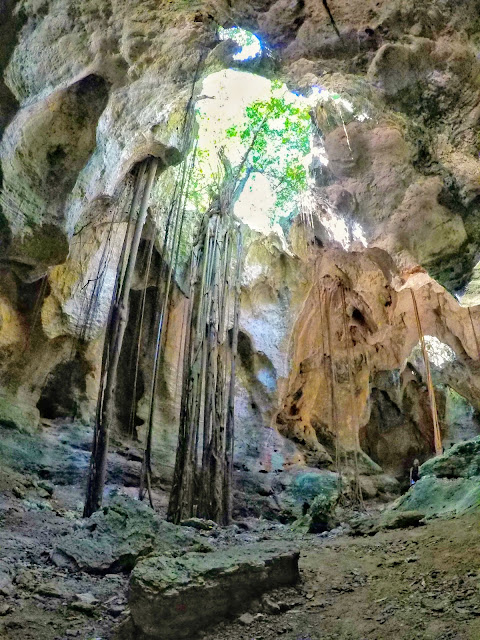A manmade bridge long ago replaced the natural arch, which was destroyed by crashing waves reported as high as 100 feet. In the 1990s, one of those walls of water pushed the bridge 7 feet to the west. Sadly, during strong storms tourists often stop along the bridge and bluffs to watch the crashing waves, and several in recent years have been carried away by the water.
Just south of the Glass Window are the Queen's Baths, where waves have carved natural pools into the rocks, which fill with water, and at low tide get warmed by the afternoon sun, making perfect dipping baths.
Compared to Abaco, where palm trees and sandy beaches are aplenty, much of Eleuthera has a rockier, reef shoreline, with pine tree woods covering steep cliffs. That said, we had a lovely beach day on January 17, when we anchored for one night at Ten Bay Beach, with its 100-plus feet of soft white sandbar that appears at low tide.

Trash disposal is a challenge in the Bahamas, since there is no easy way to excavate landfills. So (smelly) plumes of burning trash are common throughout the islands.
On the sail south the next day, we landed our very first fish, a large mutton snapper, which took Nick almost 15 minutes to get onboard. Since large reef fish like this in the Bahamas can cause a seafood toxic illness called cigaterra poisoning we tossed it back into the sea.
Rock Sound and Wind for Days
After leaving Ten Bay, we had a great 20 nm sail south to Rock Sound, a well protected bay at the southern end of Eleuthera, where we were seeking safe harbor from an approaching front. We arrived to Rock Sound on Friday, January 18 and for almost a week it blew 20-plus knots of wind. 
The Bahamian islands are close to North America and are often affected by the same continental weather and fronts that bring the U.S. its cold and snow; to the Bahamas those fronts bring squally rain storms and SO MUCH wind.
When it's blowing a sustained 20+ knots of wind, it can be uncomfortable to move about aboard (as the boat rocks in the wind and waves), and the swell created from the wind makes it too difficult and dangerous to go ashore in a small dinghy. We also have to worry about other boats (and ours) dragging on its anchor if winds get too strong. So we stay aboard during blows and do whatever we can to pass the time - read, tackle boat maintenance projects, watch movies, cook, clean and get crafty.
 |
| During our five days in Rock Sound, we moved back and forth across the bay to seek protection from the shifting winds |
 |
| Sara tackling some sewing projects during the blow |
Thankfully between fronts, we were able to go ashore for two happy hours with fellow cruisers and to do some sightseeing around Rock Sound and Cape Eleuthera island. We visited Ocean Hole, a large ocean hole in the town's center, which many say has healing powers. While at the blue hole, Nick pet a family of friendly feral canines, which then followed along with us for several hours and miles as we explored town.
 |
| While we didn’t see any bats in the caves, this giant moth came aboard one evening and chased us around for a few minutes before departing from an open hatch |
Exumas, Bahamas
On Friday, January 25, a week after we arrived in Rock Sound, we weighed anchor and headed 40 nm offshore to the southern Bahamas and the Exumas islands. We'd planned to head for Highbourne Cay, but winds were on the nose (and a sailboat can't sail directly into the wind), so we pointed our bow further south to Warderick Wells Cay in the Exuma Cays Land and Sea Park. Winds waned throughout the 8-hour passage, so we were forced to motor sail with the engine for much of the trip to ensure we made it through the unfamiliar cut and shallow waters in daylight.Along the way, we landed a gorgeous mahi on our trolling rod. Nick reeled for quite some time to get it close to the boat, but we lost the fish within 10 feet of our stern, when it jumped free on the slackened fishing line. Thankfully, the rest of the day and trip was uneventful, and we arrived before dusk with enough time for a quick swim in the ocean.
Despite some bad fishing luck the day before, the following morning we decided to move Borealis to one of the park's mooring fields, and chose to do it before lunch and a hike. Thank goodness we did, because as soon as we got settled on the mooring and finished our lunch, a strong (and not forecasted) squall came through gusting to 30 knots. For the next few hours we watched helplessly as boats streamed through the shallow and rocky barrier cut in large 8-to 10-foot seas and struggled in the strong current and wind to hook their moorings (many of the boats had been anchored with us earlier in the week in Rock Sound).
Exploring the Exumas Next
The Exuma chain consists of 365 cays and islands and are some of the most popular in the Bahamas; they are often the location of photos showing the stunning blue waters and sandy beaches of the Bahama islands. We can't wait to explore more!






































No comments:
Post a Comment